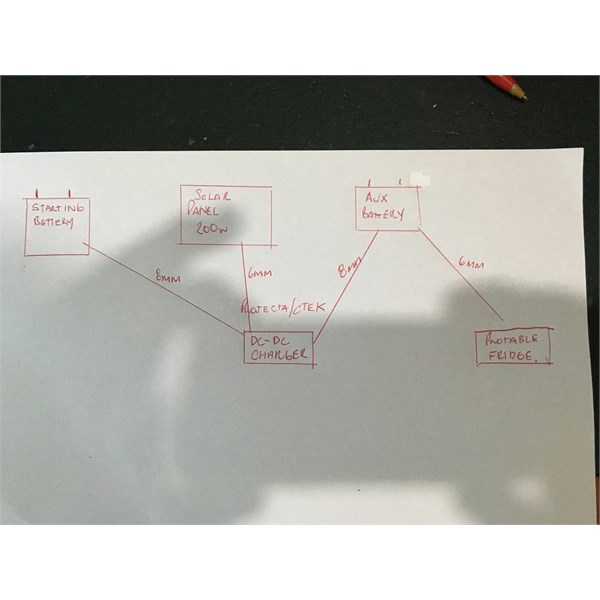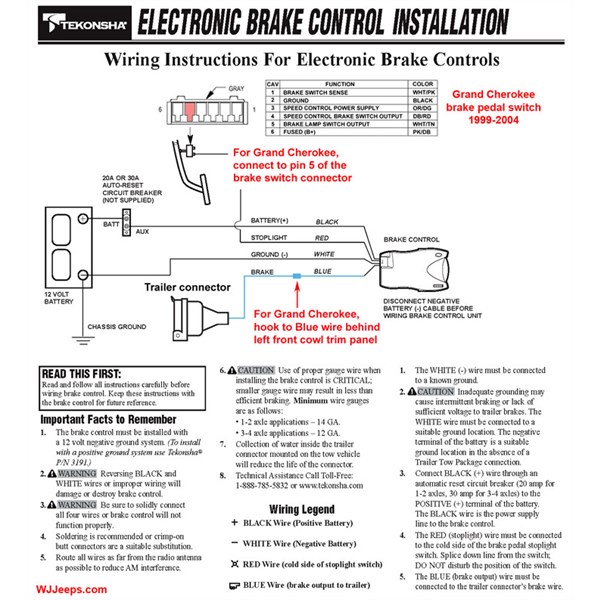Calling all 12v Gurus
Submitted: Sunday, Aug 21, 2016 at 18:53
ThreadID:
133266
Views:
5299
Replies:
5
FollowUps:
9
This Thread has been Archived
warren h1
Hi guys
Looking at setting up my triton with a 2nd battery would love any pointers
ie: Do i need any in line fuses or relay
Is the cable size right

Battery draw
Reply By: cookie1 - Sunday, Aug 21, 2016 at 19:20
Sunday, Aug 21, 2016 at 19:20
Rule # 1 Always protect the cable with a fuse at the source
- Cable coming off the Starting Battery
- Cable coming off the DC-DC, at the battery
- Cable going to the Fridge, again, at the battery
cheers
AnswerID:
603676
Reply By: Zippo - Sunday, Aug 21, 2016 at 20:12
Sunday, Aug 21, 2016 at 20:12
Apart from cookie's (good) advice re fusing, on locations and cable sizes ...
1. Try and locate the DC-DC as close as practical to the aux battery. (Volt drop on the OUTPUT does matter, so your 8mm is good to reduce it. Volt drop on the INPUT side of the DC-DC is largely immaterial - yes it affects overall efficiency of the aux charging system a bit but not the result for the aux, which is why the DC-DC is there).
2. Unless your fridge is a monster OR located a long way from the aux battery, 6mm is overkill but if it's what you have, go for it.
3. As an issue, volt drop on the solar-DC-DC run is similar to the main-aux run.
4. Projecta, C-Tek or Redarc is a matter of personal preference.
AnswerID:
603677
Follow Up By: warren h1 - Sunday, Aug 21, 2016 at 20:28
Sunday, Aug 21, 2016 at 20:28
Thanks so much would use auto reset circuit breaker or Fuse
FollowupID:
873273
Follow Up By: Zippo - Sunday, Aug 21, 2016 at 21:09
Sunday, Aug 21, 2016 at 21:09
I would personally use a fuse in any such situation. Auto-resets can/will reclose on a fault (they don't know the fault is still there until they reclose ...).
In my case - a (20A) Redarc BCDC1220 - I have 40A fuses at the cranking battery takeoff and in the tails coming off the aux to the adjacent Anderson connector. My fridge line has a 30A fuse, but it also protects a ciggie-lighter outlet adjacent.
FollowupID:
873277
Reply By: Allan B (Member, SunCoast) - Sunday, Aug 21, 2016 at 22:30
Sunday, Aug 21, 2016 at 22:30
.
Hi Warren, you may find
this information useful when setting up auxiliary battery systems. It should answer all your questions.
Also....... the following is a copy of my reply on another recent thread regarding self-resetting circuit breakers..........
"Self-resetting circuit breakers are not a good idea. If there is a short circuit they simply continue to reclose until either a) the cable melts the insulation, b) the battery goes flat, or c) the breaker self-destructs. Furthermore, I have yet to see a 12V one that I would consider to be of good quality.
Self closing breakers at any level of engineering are intended to protect a simple overload such as connecting an appliance who's load exceeds the supply capability whereupon you would observe that and disconnect the load. They are not appropriate for short-circuit protection where a fuse or manual-reset breaker should be used.
AnswerID:
603680
Follow Up By: Zippo - Monday, Aug 22, 2016 at 00:31
Monday, Aug 22, 2016 at 00:31
Apart from the type of application Allan mentioned, self-resetting breakers ("reclosers") are used in high voltage transmission lines as protection against transient faults such as lightning strikes. But the key word there is TRANSIENT.
I was once involved in a power line that was about 5km long, and in serious termite country so the poles and cross-arms were steel. At one change of direction, Corellas seemed overly inclined to stand on the cross-arms and scratch their beaks on the nearby conductors. After the bang, as they fell to the ground in a charred state the line protection would kick in. We used "three-shot reclosers" (technically 3-shot interrupters) which would open, then reclose. If the fault was still present, open and reclose again. A third opening would result in staying open, as it indicated an ongoing (non-transient) fault. In the first year of operation, over 300 "hits" were recorded but the line was never left open.
Self-resetting always incorporates a risk element, which can be serious if left unattended to just cycle. Although they were used in motor-vehicles 50-60 years ago (think Holden, headlight pull-switch assembly) I would personally never use one in my vehicles. Others may think differently of course.
FollowupID:
873285
Follow Up By: TomH - Monday, Aug 22, 2016 at 08:20
Monday, Aug 22, 2016 at 08:20
They are recommended to be used in electric brake controller circuits.
If you use a fuse and it blows the trailer will have no brakes and you wouldnt know,
Redarc recommend one be in the power circuit from the battery.
FollowupID:
873288
Follow Up By: Allan B (Member, SunCoast) - Monday, Aug 22, 2016 at 09:48
Monday, Aug 22, 2016 at 09:48
.
The question that needs to be asked Tom, is "Why would the fuse blow"? Provided that it has been correctly sized then the reason must be a short-circuit. In which case re-applying the supply would achieve nothing other than the re-closing circuit breaker opening yet again and repeatedly. The brakes still would not be working.
FollowupID:
873293
Follow Up By: Allan B (Member, SunCoast) - Monday, Aug 22, 2016 at 10:37
Monday, Aug 22, 2016 at 10:37
Actually Tom, Redarc instructions simply state "Fuses or Circuit breakers of appropriate rating must be installed to protect the vehicle system."
They do however offer a self-resetting circuit breaker (CBK30-EB) in an accessory kit.
I have emailed Redarc to ask their reason for a self-resetting CB.
FollowupID:
873295
Follow Up By: TomH - Monday, Aug 22, 2016 at 14:44
Monday, Aug 22, 2016 at 14:44
Dont know where you saw that as here are the instructions for Redarc brake controllers both the old type and the new Towpro
https://www.redarc.com.au/wiring-diagrams/wire-up-your-tow-pro
Neither mention fuses. The only one that does is the 24/12 volt model
Neither do Tekonsha as per these diagrams

P3 wiring diagram

Tekonsha
I was specifically told never to put a fuse in a brake circuit so I didnt.
I presumed that it was that even if you had a fault a breaker may allow some braking whereas a fuse wouldnt
FollowupID:
873302
Follow Up By: Allan B (Member, SunCoast) - Monday, Aug 22, 2016 at 17:26
Monday, Aug 22, 2016 at 17:26
.
I guess it's where you look Tom.
The following is copies\d from Redarc's EBRHV2 Manual online............
"3. Fuses or Circuit breakers of appropriate rating must be installed to protect the vehicle system. Please refer to the installation instructions on page 6 for specific instructions on where to install Fuses or Circuit Breakers and for appropriate Fuse or Circuit Breaker ratings. Fuses must be installed as close as possible to the battery."
If you do have a short circuit in the supply line then even a circuit breaker will not "allow some braking".
I have yet to receive a response from Redarc on this.
FollowupID:
873308
Follow Up By: TomH - Monday, Aug 22, 2016 at 22:12
Monday, Aug 22, 2016 at 22:12
Wonder why they write that and in all the wiring diagrams show ONLY circuit breakers. Maybe the office girl wrote that one.
From the "Etrailer " Site
For brake controllers we do not recommend that fuses be installed in place of circuit breakers. One reason for this is that an auto reset circuit breaker will reset if there is an intermittent short, once the short is no longer present on the circuit, and braking performance would be restored. With a fuse, once blown, braking performance is terminated until the fuse is physically replaced.
FollowupID:
873335
Reply By: swampy - Monday, Aug 22, 2016 at 13:34
Monday, Aug 22, 2016 at 13:34
Hi
Warren H1
Wiring size
Solar, to harvest every ounce go 7.9mm2 / 8b&s [8mm2]
I take it your referring to 6mm is the auto type which is actually 4.5mm2
A fridge that run up to 40 ltrs and cord no longer than 6mtrs long can use 4.5mm2 if bigger or longer u need 8b&s
Fuse every thing
use a earth circuit cable not chassis
Solder joints where u can and be fussy with your crimping
Use sticky heatshrink
Conduit cables or purchase twin core sheath cable
tomo
AnswerID:
603701
Reply By: gbc - Monday, Aug 22, 2016 at 17:39
Monday, Aug 22, 2016 at 17:39
I see you have ctec and projecta on your board. I have both. The ctec has more smarts and will back charge the start battery etc which the projecta won't.
Also the ctec is internally fused and your fridge will be fused as
well.
AnswerID:
603708